PRESTO PLANS
Sent straight to your inbox
CLICK HERE TO ACCESS
Sign up to receive 10 ready-to-use ELA resources your students will love!
10 FREE ELA RESOURCES
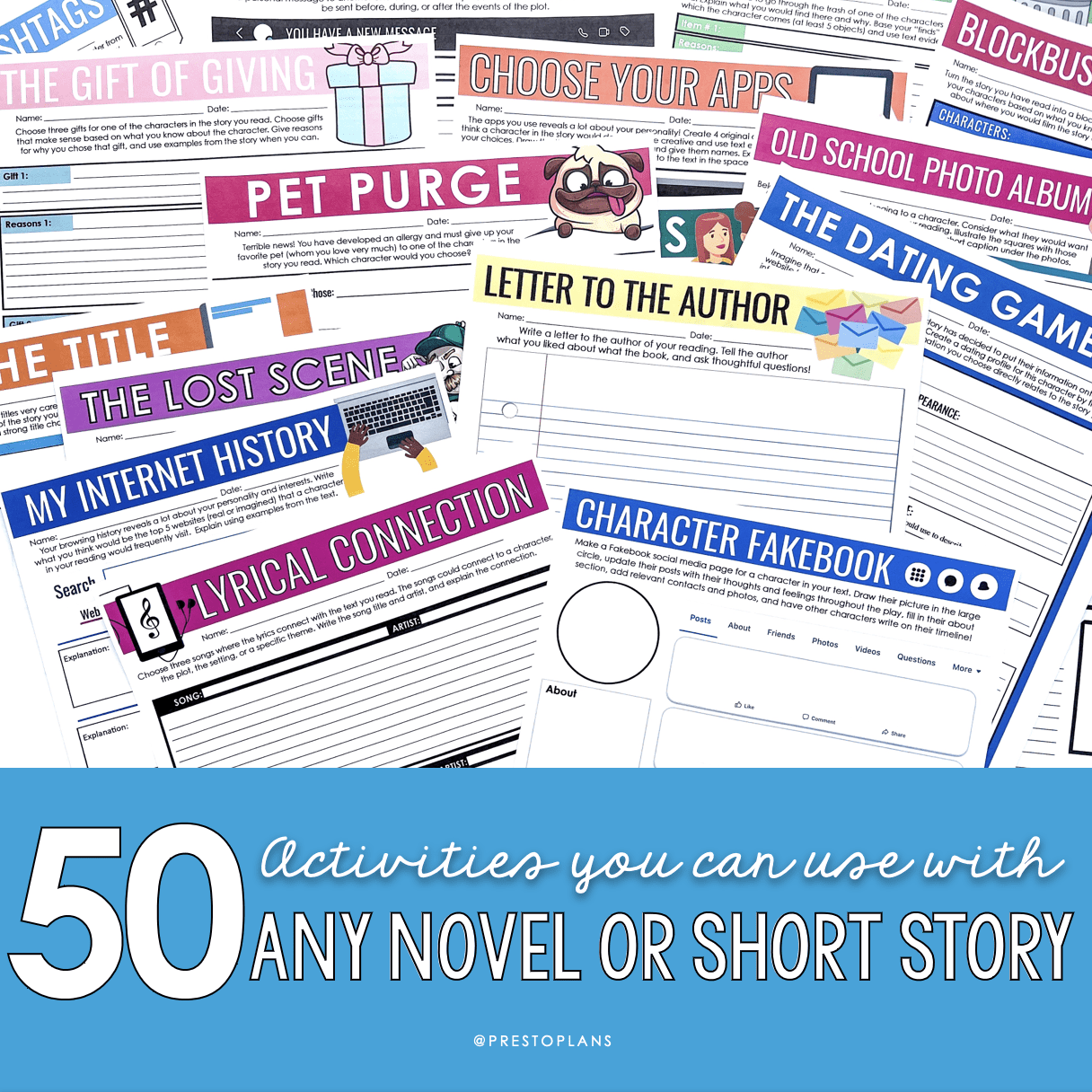
50 Activities You Can Use With Any Novel or Short Story
Incorporating engaging, hands-on activities for novels or short stories can breathe new life into any ELA unit! If you’re looking to get out of the book report rut, differentiate a novel study for learners of all abilities, inspire students to engage more deeply with their reading, or get a squirrelly class up and moving, a little bit of creativity can go a long way!
This week, I’ve rounded up some of my favorite engaging activities for novels and short stories. They work with any fictional text, and – best of all – many of them involve very minimal prep work! Here are 50 (yes, you read that right – FIFTY!) creative assignments and activities you can use with any novel or short story!
Make Connections
Good readers know how to make connections between texts, themselves, and the wider world. These activities for novels and short stories help students explore the various connections they can make to their reading.
- Fast Friends: Could your students be friends with the characters in their novel or short story? Why or why not?
- Dare to Compare: Students compare a character to someone in their life, using evidence to support their statements.
- Red Carpet Comparison: Do the characters in the novel or short story remind students of celebrities or public figures?
- Lyrical Connection: Music lovers can connect the lyrics of a song to characters, events, or even a time period represented in the book!
- Pet Purge: Which character in the story would your students trust to take care of a beloved pet?
- What Did You Pack? What would students put in their bags if they were joining the characters of their story on a week-long adventure?
Explore Characters
Characters are the heart of any work of fiction. All these activities for novels or short stories are designed to help students understand and explore characters more deeply.
- Character Obituary: Even if a character hasn’t actually died, writing their “obituary” shares information about their life, family, interests, and activities.
- Hashtags: Students imagine they are a character and create social media updates (including hashtags)!
- TxT Me L8R: Your class can imagine two characters exchanging text messages during an important moment in the plot. What would they say?
- Point of View Change Up: Students can retell a part of the story from a different character’s perspective!
- My Internet History: What would a character’s browsing history look like as the plot of the story unfolds?
- The Change-Up: Students explore how the main character has changed from the beginning to the end of the story.
- Snail Mail Postcard: Imagine that one character wants to send a postcard to another. What would they say?
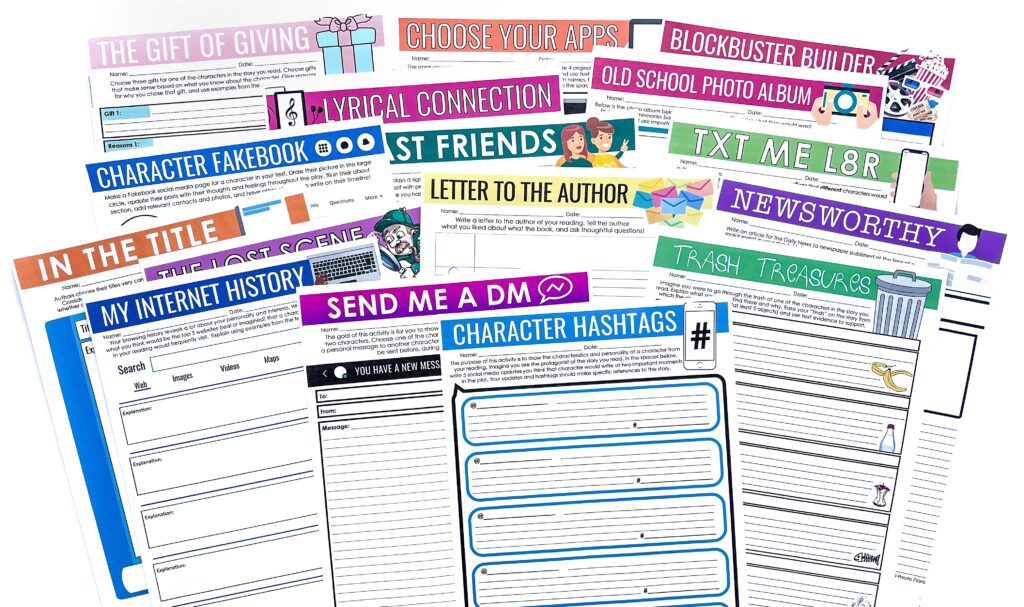
- The Gift of Giving: Consider what would make a good gift to “give” one of the characters in the story!
- Character Fakebook: Creative students will love designing a social media profile for one of the characters in their chosen text.
- Send Me a DM: Students imagine the contents of a personal message sent from one character to another (at any point in the story!).
- Old School Photo Album: What memories would be important to a character? Students use a provided template to design a “photo album” commemorating their character’s most significant moments.
- The Dating Game: What would a character include in their online dating profile (and what information might they leave out?)?
- Trash Treasures: What does a person’s trash say about them? Students will love considering the items that could be found in a character’s trash!
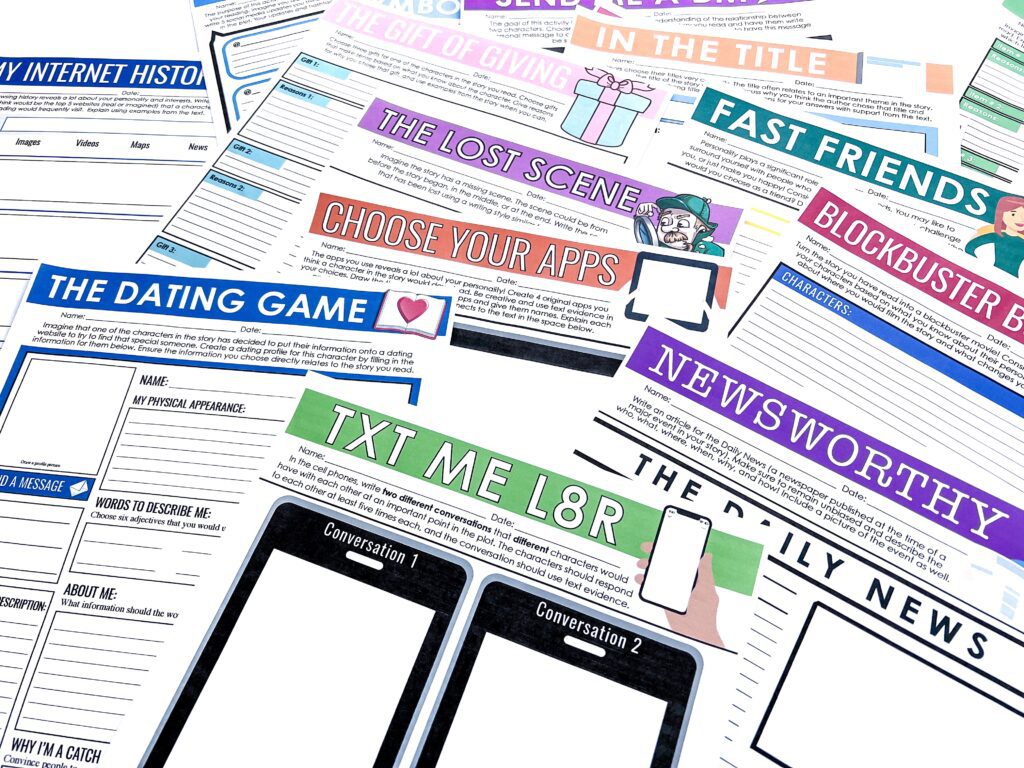
Plot and Purpose
Encourage students to go beyond simple summaries with these creative activities for novels and short stories related to plot and writer’s craft!
- Author Extraordinaire: Students imagine they are the author of the story and discuss their writing process!
- Book Club Leader: Book club leaders must provide a series of open-ended discussion questions to spark lively conversation and debate!
- The Problem Solver: Students consider the conflicts (or problems) the main character faces in the story. Were they able to “solve” their problems?
- Who’s That?: What would happen if a new character was added to the story, and what purpose would they serve in the plot? Students consider how a new character could change the story.
- Quotation Query: A provided graphic organizer helps students select significant quotes from the story and explain their importance.
- In the Title: Students consider what makes a strong title and evaluate whether the title of their story makes the grade!
- Book Cover Creation: Students create an “alternative” design for the cover of the book that appeals to future readers, and summarizes the plot (without spoilers!).
- Story Timeline: A graphic organizer that can be used during and after reading to help students make sense of major plot points.
- Symbol Search: Students identify various symbols that appear in their story and what they represent.
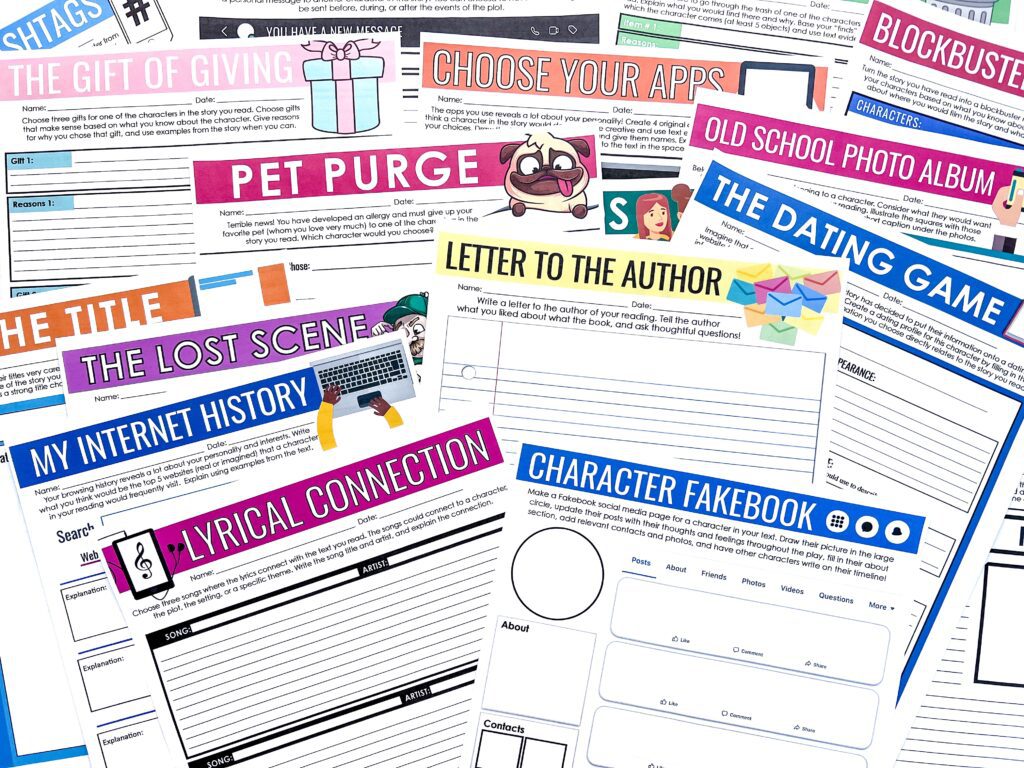
Places and Spaces
All stories need a setting! Support students as they explore the locations and time periods where their text takes place with these creative activities for short stories or novels.
- The Setting Tour Guide: Take on the role of tour guide by writing a description of the story’s setting!
- Be a Cartographer: Visual students may enjoy drawing a map of the setting, labeling the most important places, and explaining their significance.
- Setting Brochure: Travel brochures can really help to “sell” a destination. How will your students sell the setting of a chosen story or novel?
- Setting Swap: What would happen if the setting of the story was changed to somewhere else in the world (or a different time period?)?
- Setting Venn Diagram: Students compare and contrast the setting of the story with their current location.
Write About Reading
Good readers make good writers! Help students express their ideas confidently and creatively with these writing activities for novels or short stories.
- Letter to the Author: Students can take the opportunity to tell the author of the novel or story what they liked about the book, and ask thoughtful questions!
- Blog Review: Taking on the role of a famous literary blogger, students provide a full review of the story. Will they recommend the book?
- Change the Ending: Were students disappointed with the ending of their story or novel? Encourage them to write an alternate ending!
- Newsworthy: Gumshoes get ready! In an unbiased newspaper article, student “reporters” must describe an event from the story, complete with a picture!
- The Lost Scene: Creative writers might like to envision a “deleted scene” from the story, in the style of the author!
- To the Movie Producer: Aspiring filmmakers can compose a letter to a well-known movie producer, pitching the novel or short story as an appealing feature film!
- Psychic Moment: Forward-thinking students imagine what happens to characters from the story 20 years into the future!
- Dear Diary: Thoughtful students may enjoy taking on the persona of a character from your novel or short story in this creative writing task.
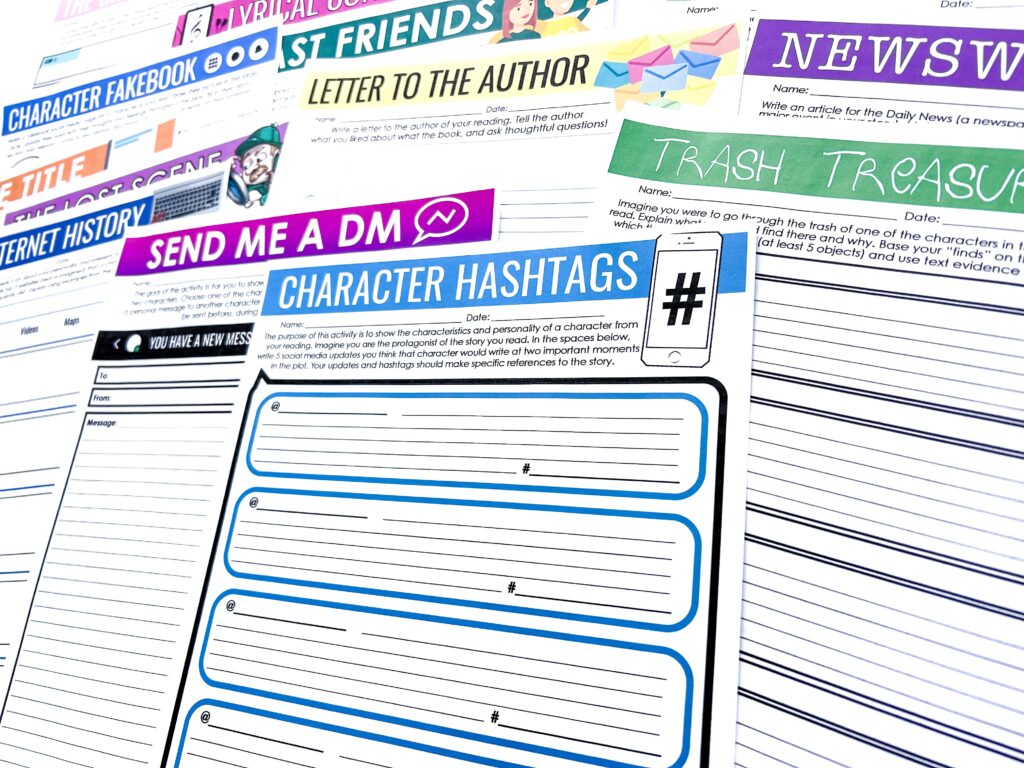
Get Creative
I love seeing what students can do with a little bit of creative freedom to express their understanding of a text. Here are some of my favorite outside-the-box activities for any text.
- Blockbuster Builder: Movie buffs can develop a plan to turn the story or novel into a movie. They’ll need to consider which actors will play the characters, locations for the film shoot, and any plot changes!
- Interview Skills: Using a provided graphic organizer, reporters-in-training prepare for a sit-down interview with any character from the book.
- Poet Laureate: Budding poets can show off their skills by composing two cinquain poems and an acrostic poem about characters from their reading.
- Comic Creator: Using a provided panel template, students re-create a memorable scene from the book as a comic strip!
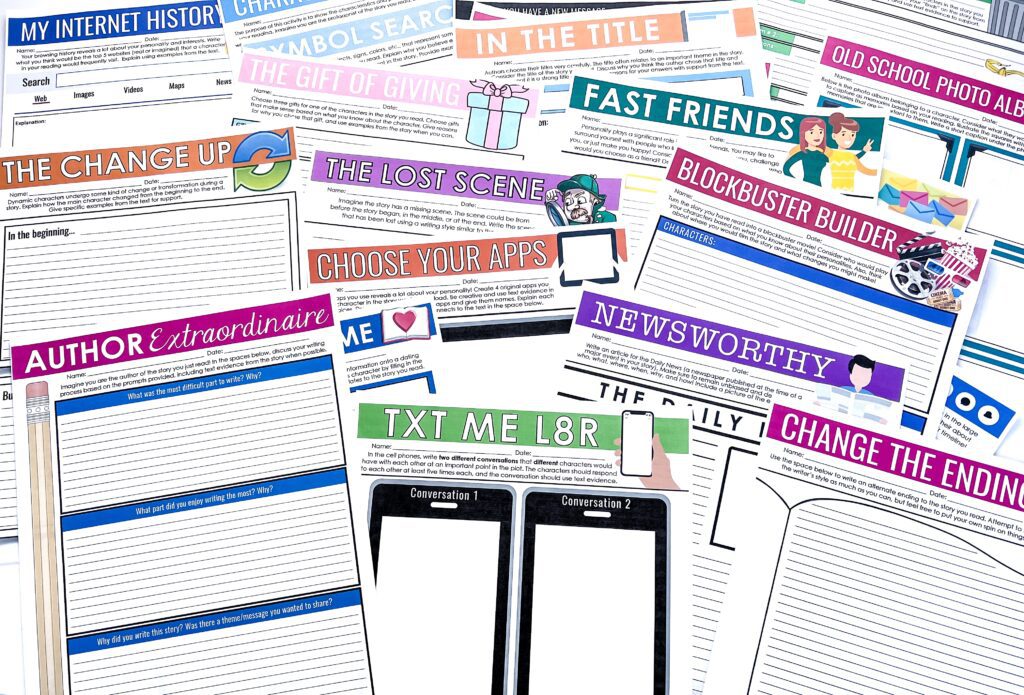
- Bookmark Builder: Creative students will love designing bookmarks based on the characters, setting, or events of the story!
- Choose Your Apps: Apps make everyone’s lives easier! Which original apps would help a character from the story? Students must explain each app’s functions in detail, create a logo, and give it a name!
- Writing Rap Rhymes: Considering plot, characters, themes, or setting, students compose a creative rap about the novel or short story.
- Costume Designer: What would the main character wear? Using a provided template, students design an outfit for the main character and explain it from a fashion (and functional!) perspective.
- Movie Poster: Artistic students will love designing the poster for an imagined feature film version of the story!
There you go! I hope these activities give you plenty of ideas to help you make the most of your next short story or novel study!

For another similarly versatile activity that works well with most fiction texts, have a look at my post for Turning a Story Into a Video Game.
Search the blog for what you are teaching
GIVEAWAYS
sent straight to your inbox!
share this post